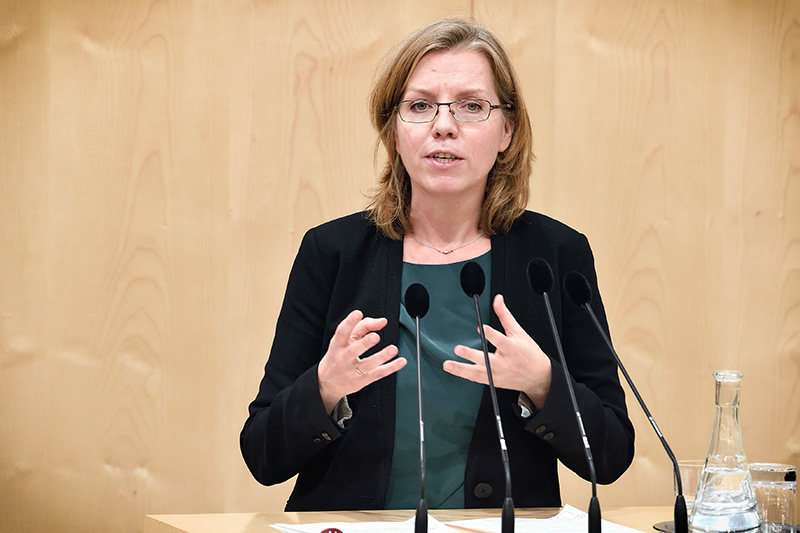Climate Protection Minister Leonore Gewessler presented the final Austrian Energy and Climate Plan (NEKP) today and will now submit it to the EU Commission. The EU’s climate targets stipulate that Austria should reduce its greenhouse gas emissions by 46-48% by 2030 – the plan now outlines how this target is to be achieved.
This is the second attempt at a submission: Minister Gewessler first sent a draft to Brussels in December 2023, but it was withdrawn by European Affairs Minister Caroline Edtstadler (ÖVP). At the time, it was said that the plan had not been agreed with the ÖVP and other ministries. The concerns have now been addressed – probably also due to time pressure: Austria was the only country that had not yet submitted a national energy and climate plan.
Infringement proceedings have already been initiated as the deadline was not met: The EU member states were supposed to submit the final, updated plans by June 30, 2024, having already incorporated the EU Commission’s recommendations.
Only now has the black-green government been able to agree on a joint concept.
Subscribe to our newsletter

What is the National Climate Plan?
There are four EU-wide targets for 2030: reduction of greenhouse gas emissions, expansion of the electricity network, a minimum share of 32% of renewable energies and a minimum improvement in energy efficiency of 32.5%.
In the national climate plans, the EU member states set out how they intend to achieve these binding EU climate targets by 2030. Reducing greenhouse gas emissions by 48% compared to the base year 2005 is an ambitious plan that aims to reduce them by around 30 million tons of CO2 per year.
What measures should be taken in Austria to achieve this?
- Climate-damaging subsidies will be reduced
The abolition of the diesel privilege (mineral oil tax on diesel is 8.5 cents/litre lower than on petrol) and tax benefits for company cars should save at least 2 million tons of CO2.
However, this is only part of a plan yet to be developed, which is now to be drawn up by the Ministry of Finance with the help of an inter-ministerial working group.
The commuter allowance is also to remain, but is to be reformed. Here, too, the Ministry of Finance is called upon to come up with a concrete measure. - Continuation of the high subsidies for replacing heating systems and renovating buildings until 2030
The high subsidies should continue to be an incentive to replace gas and oil heating systems and implement thermal renovations. Refurbishments are a major lever, as buildings are built to last – and due to the far too low refurbishment rate, many fossil heating systems are still active. Fossil energy sources have been cheap for many years, which is why 35% of the 4 million main residences in the country are still heated with fossil fuels (22% natural gas, 13% heating oil; source: energie.gv.at). The biggest criticism of the current approach: The measures must be be paid for in advance and the subsidy is only refunded afterwards. - Expansion of hydrogen production for use in industry
There are sectors and areas that cannot be electrified – namely where a high energy density is required (e.g. in aircraft, in industry). E-fuels and hydrogen are needed there to decarbonize these combustion processes, which require extreme heat. - Use of permanent CO2 storage
To date, CO2 storage is still prohibited, but in future residual emissions are to be resolved in sectors in which climate-damaging greenhouse gas emissions are difficult or impossible to avoid – e.g. in the cement industry.
The aim is to save a further 500,000 tons of CO2. The government has already presented a carbon management strategy for this purpose. - Further expansion of renewable energies
The commitment to the further expansion of renewable energies is hardly surprising, but this must also include a consistent restructuring of the energy system and expansion of the distribution grid, which is bursting at the seams.
The distribution grid operators put these investments at EUR 24 billion, and APG puts its investment requirements at EUR 9 billion according to the grid development plan.

National climate plan: How Austria wants to reduce its CO2 footprint by almost half
Climate Protection Minister Leonore Gewessler presented the Austrian Energy and Climate Plan (NEKP) and will now submit it to the EU Commission.
This is the second attempt at a submission: Minister Gewessler first sent a draft to Brussels in December 2023, but it was withdrawn by European Affairs Minister Caroline Edtstadler (ÖVP).

AI for seniors: How artificial intelligence enables self-determined living
In view of the shortage of nursing staff, AI-supported assistance systems for the home are becoming increasingly urgent. In Germany alone, there will be a shortage of over 3 million homes suitable for the elderly and over 600,000 care workers by 2030. Technology that already provides support in care facilities is now also available on the market for private households.
The criticism
Automobile clubs, agriculture and industry are not very pleased about the much-discussed end of the diesel privilege: a few months ago, the Farmers’ Association demanded further relief for farmers, as they would suffer from the third-highest taxation on agricultural diesel compared to other EU countries. This would lead to a “decisive” competitive disadvantage for domestic family farms. During the press conference, Gewessler also addressed the “fuel tourism” of European hauliers, which she wanted to combat – that is the flip side.
Citizens who have received a kind of mileage allowance for decades in the form of the commuter allowance will also be pleased. With a distance of more than 60 km to the workplace, this allowance amounted to EUR 306/month or EUR 3,672/year.
Industry, on the other hand, is concerned about the competitiveness of domestic companies. European and national climate policy must be accompanied by an ambitious industrial policy in order to safeguard Europe as a business location. In particular, the overfulfilment of long-term targets, i.e. so-called “gold plating”, is viewed critically.
Furthermore
Our conclusion:
The measures are still very half-baked and promise to be very explosive in the coming governments. Many of the measures will now only be translated into concrete measures by the Ministry of Finance, concrete laws are missing. The document presented therefore remains a basis on which the next government will now have to build concrete measures.
What remains is the stale aftertaste of a political necessity that was created with a dwindling willingness to compromise on the part of the acting parties due to the upcoming elections in September ’24.
The Austrian Energy and climate plan can be downloaded here
Information sheet on the renovation bonus for private individuals
Overview of the Austrian
Subsidies for building, renovation and refurbishment
Photo credits header: Shutterstock






